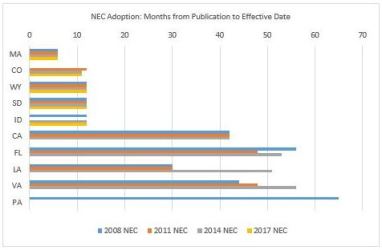
Report Warns Some States Falling Behind on Electrical Safety
NFPA noted that from 2010 to 2014, an annual average of more than 61,000 fires in the United States were attributed to electrical failures or malfunctions, causing more than $2 billion in losses and killing an average of 432 people each year.
A new report from the NFPA Fire & Life Safety Policy Institute, "Falling Behind on Electrical Safety," warns that about one-third of the states are skipping one or more updates of NFPA 70: National Electrical Code®, and other states are amending the code to remove safety requirements. This means many homes, schools, and businesses are not taking advantage of the advances in safety offered by each NEC update and may ultimately stall the fight against electrical fires and injuries, according to the report.
It reveals wide variations in state adoptions of NEC and neglect of electrical safety, which raises risks for first responders and workers, according to NFPA.
The association noted that from 2010 to 2014, an annual average of more than 61,000 fires in the United States were attributed to electrical failures or malfunctions, causing more than $2 billion in losses and killing an average of 432 people each year. Updates made to the NEC every three years help drive those numbers down by incorporating advances in knowledge and technology, such as the requirement to use arc fault circuit interrupters (AFCIs), ground fault circuit interrupters (GFCIs), and tamper-resistant receptacles.
Updates also include provisions to decrease the risk of arc flashes from high-voltage electrical equipment and requirements for the rapid shutdown of photovoltaic (PV) systems to protect firefighters who may need to access locations charged with photovoltaics.
 A graph showing slowest and fastest adopters of the four most recent versions of the NEC indicates California, Florida, Louisiana, Virginia, and Pennsylvania are the slowest five states.
A graph showing slowest and fastest adopters of the four most recent versions of the NEC indicates California, Florida, Louisiana, Virginia, and Pennsylvania are the slowest five states.
"The longer states wait to adopt, the longer they delay or fall behind in advancing electrical safety. This flatly goes against public expectations," said NFPA Fire & Life Safety Policy Institute Director Meghan Housewright, referring to a 2017 NFPA survey of U.S. consumers showing more than 80 percent of U.S. residents expect government to adopt and enforce up-to-date safety codes.
The new report said factors that contribute to mismatched NEC adoption practices across the country include: greater political pressure and involvement from state legislators; increased scrutiny of regulatory activities; consideration of cost alone without consideration of benefits; and less independence for appointed experts involved in code adoption activities. The institute recommends that state policymakers take advantage of the robust national process used to update the NEC, and that states:
- Rely on experts in order to maintain a robust level of expertise that will enable timely adoption -- states should rely on electrical regulatory boards to update the electrical code and implement statewide licensing for electricians. States with electrical boards are more efficient, tending to adopt new updates in about half the time as states that do not use an electrical regulatory board.
- Prioritize adoption of the NEC. The electrical code is just one of several nationally developed codes that impact construction. Waiting to adopt the NEC updates with other codes creates inevitable delays in advancing electrical safety and technology.
- Consider costs holistically and in context. Every year, electrical-related fires are responsible for an average of more than $2 billion in direct property losses. Focusing solely on costs of compliance ignores potential benefits of lives and dollars saved through preventing fire and accidents.
"Policymakers can make the difference to ensure residents are safe in their homes and businesses, but the fact is, while some states do this well, many others do not," Housewright said. "Governments should take steps to improve safety for the citizens they serve."
The National Fire Protection Association created the institute to support policymakers around the world protect people and property from fire and other hazards with best practice recommendations and approaches to develop and sustain a strong fire prevention and protection system. For more information, visit www.nfpa.org/policyinstitute.